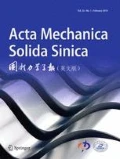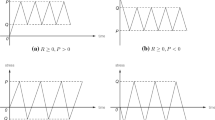Abstract
A new finite strain elastoplastic \(J_{\mathrm {2}}\)-flow model is established with an explicit formulation of work-hardening and softening effects up to eventual failure, in which both a new flow rule free of yielding and an asymptotically vanishing stress limit are incorporated. The novelties of this new model are as follows: (i) Fatigue failure effects under repeated loading conditions with either constant or varying amplitudes are automatically characterized as inherent response features; (ii) neither additional damage-like variables nor failure criteria need to be involved; and (iii) both high- and low-cycle fatigue effects may be simultaneously treated. A fast and efficient algorithm of high accuracy is proposed for directly simulating high- and medium–high-cycle fatigue failure effects under repeated loading conditions. Toward this goal, a direct and explicit relationship between the fatigue life and the stress amplitude is obtained by means of explicit and direct procedures of integrating the coupled elastoplastic rate equations for any given number of loading–unloading cycles with varying stress amplitudes. Numerical examples suggest that the new algorithm is much more fast and efficient than usual tedious and very time-consuming integration procedures.





Similar content being viewed by others
References
Ritchie RO, Gilbert CJ, McNaney JN. Mechanics and mechanisms of fatigue damage and crack growth in advanced materials. Int J Solids Struct. 2000;37:311–28.
Susmel L. The theory of critical distances: a review of its applications in fatigue. Eng Fract Mech. 2008;75:1706–26.
Rozumek D, Macha E. A survey of failure criteria and parameters in mixed-mode fatigue crack growth. Mater Sci. 2009;45:190–206.
Argon AS. Topics in fracture and fatigue. New York: Springer; 1992.
Fine ME. Fatigue resistance of metals. Metall Trans A. 1980;11(3):365–79.
Kallmeyer AR, Krgo A, Kurath P. Evaluation of multiaxial fatigue life prediction methodologies for Ti6Al4V. ASME J Eng Mater Technol. 2002;124:229–37.
Jiang Y, Ott W, Baum C, Vormwald M, Nowack H. Fatigue life predictions by integrating EVICD fatigue damage model and an advanced cyclic plasticity theory. Int J Plast. 2009;25:780–801.
Talreja R. A mechanisms-based reliability model for fatigue of composite laminates. ZAMM-J Appl Math Mech. 2015;95:1058–66.
Li J, Li CW, Zhang ZP. Modeling of stable cyclic stress-strain responses under non-propotional loading. ZAMM-J Appl Math Mech. 2017;97:388–411.
He MM, Li N, Huang BQ, Zhu CH, Chen YS. Plastic strain energy model for rock salt under fatigue loading. Acta Mech Solida Sin. 2018;31:322–31.
Liu JH, Pan XM, Wei YB, Wang YL. Method for predicting the fatigue life of geometrically discontinuous structures under combined bending and torsion. Acta Mech Solida Sin. 2019;32:367–77.
Bathias C. There is no infinite fatigue life in metallic materials. Fatigue Fract Eng Mater Struct. 1999;22:559–67.
Murakami Nomoto YT, Ueda T. Factors influencing the mechanism of superlong fatigue failure in steels. Fatigue Fract Eng Mater Struct. 1999;22:581–92.
Chamat A, Abbadi M, Gilgert J, Cocheteux F, Azari Z. A new non-local criterion in high-cycle multiaxial fatigue for non-proportional loadings. Int J Fatigue. 2007;29:1465–74.
Liu WC, Dong J, Zhang P, et al. High cycle fatigue behavior of as-extruded ZK60 magnesium alloy. J Mater Sci. 2009;44(11):2916–24.
Zhan ZX, Hu WP, Zhang M, Meng QC. Revised damage evolution equation for high cycle fatigue life prediction of aluminum alloy LC4 under uniaxial loading. Appl Math Mech-Engl Ed. 2015;36:1185–96.
Zhang SQ, Zhang YC, Chen M, Wang YJ, Cui Q, Wu R, Arola D, Zhang DS. Characterization of mechanical properties of aluminum cast alloy at elevated temperature. Appl Math Mech-Engl Ed. 2018;39:967–80.
Ma YQ, Wang XP, An L. Fatigue life prediction of ductile iron based on DE-SVM algorithm. Phys Procedia. 2012;33:1309–15.
Tomaszewski T, Sempruch J. Analysis of size effect in high-cycle fatigue for EN AW-6063. Solid State Phenom. 2014;224:75–80.
Guo FM, Feng ML, Nie DF, Xu JQ, Bhuiyan MS, Mutoh Y. Fatigue life prediction of SUS 630(H900) steel under high cycle loading. Acta Mech Solida Sin. 2013;26:584–91.
Sun LL, Zhang M, Hu WP, Meng QC. Tension-torsion high-cycle fatigue life prediction of 2A12-T4 aluminium alloy by considering the anisotropic damage: model, parameter identification, and numerical implementation. Acta Mech Solida Sin. 2016;29:391–406.
Shen F, Hu WP, Meng QC. New approach based on continuum damage mechanics with simple parameter identification to fretting fatigue life prediction. Appl Math Mech-Engl Ed. 2015;36:1539–54.
Xiao H, Bruhns OT, Meyers A. Free rate-independent elastoplastic equations. ZAMM-J Appl Math Mech. 2014;94:461–75.
Xiao H. Thermo-coupled elastoplasticity model with asymptotic loss of the material strength. Int J Plast. 2014;63:211–25.
Wang ZL, Li H, Yin ZN, Xiao H. A new, direct approach toward modeling thermocoupled fatigue failure behavior of metals and alloys. Acta Mech Solida Sin. 2017;30:1–12.
Wang ZL, Xiao H. Direct modeling of multiaxial fatigue failure for metals. Int J Solids Struct. 2017;125:216–29.
Wang SY, Zhan L, Wang ZL, Yin ZN, Xiao H. A direct approach toward simulating cyclic and non-cyclic fatigue failure of metals. Acta Mech. 2017;228:4325–39.
Wang YS, Zhan L, Xi HF, Xiao H. Coupling effects of finite rotation and strain-induced anisotropy on monotonic and cyclic failure of metals. Acta Mech. 2018;229:2963–75.
Zhan L, Wang SY, Xi HF, Xiao H. Direct simulation of thermo-coupled fatigue failure for metals. ZAMM-J Appl Math Mech. 2018;98:856–69.
Zhan L, Wang SY, Xi HF, Xiao H. Innovative elastoplastic J2-flow model incorporating cyclic and non-cyclic failure effects of metals as inherent constitutive features. ZAMM-J Appl Math Mech. 2019;. https://doi.org/10.1002/zamm.201900023.
Xiao H, Bruhns OT, Meyers A. Logarithmic strain, logarithmic spin and logarithmic rate. Acta Mech. 1997;124:89–103.
Xiao H, Bruhns OT, Meyers A. Elastoplasticity beyond small deformations. Acta Mech. 2006;182:31–111.
Wang SY, Zhan L, Xi HF, Bruhns OT, Xiao H. Hencky strain and logarithmic rate for unified approach to constitutive modeling of continua. In: Altenbach H, Öchsner A, editors. State of the Art and Future Trend in Material Modeling. Advanced Structured Materials, vol. 100. Berlin: Springer; 2019. p. 443–84.
Bell JF. The experimental foundations of solid mechanics. In: Truesdell C, editor. Handbuch der Physik. Berlin: Springer; 1973.
Dub S, Novikov N, Milman Y. The transition from elastic to plastic behaviour in an Al–Cu–Fe quasicrystal studied by cyclic nanoindentation. Philos Mag A. 2002;82:2161–9.
Acknowledgements
This study was carried out under the joint support of the fund from NSFC (No. 11372172) and the start-up fund from Jinan University, Guangzhou, China.
Author information
Authors and Affiliations
Corresponding author
Rights and permissions
About this article
Cite this article
Wang, SY., Zhan, L., Xi, HF. et al. A Unified Approach Toward Simulating Constant and Varying Amplitude Fatigue Failure Effects of Metals with Fast and Efficient Algorithms. Acta Mech. Solida Sin. 34, 53–64 (2021). https://doi.org/10.1007/s10338-020-00187-8
Received:
Revised:
Accepted:
Published:
Issue Date:
DOI: https://doi.org/10.1007/s10338-020-00187-8



